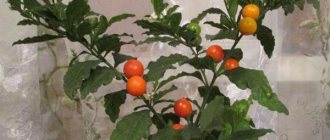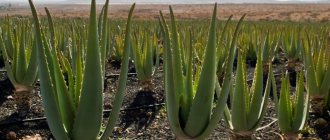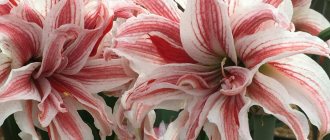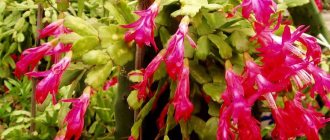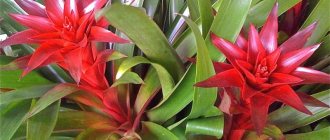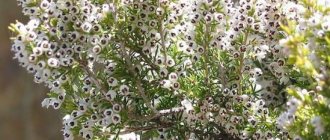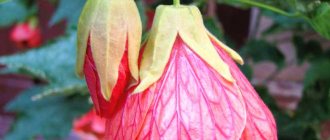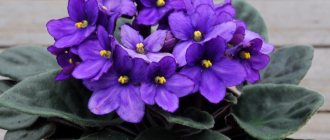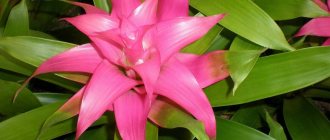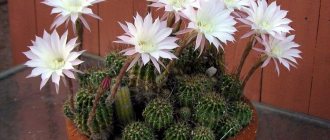Lily (lat. Lilium) is a beautiful flowering bulbous plant belonging to the Liliaceae (lat. Liliaceae). It is a herbaceous perennial growing from bulbs. The extensive Liliaceae family includes more than 100 species of this amazing flower, whose homeland is considered to be East Asia. For their elegant appearance, beauty of flowers and delicate aroma, lilies have earned the love of flower growers around the world and are now grown in all corners of the planet.
Work on breeding plant hybrids began in the 19th century and continues to this day. Breeders managed to obtain more than 8,000 new varieties that amaze with their exotic colors and aromas.
Many varieties of the “princess of flowers,” as the lily is rightly called, are cultivated by gardeners in their garden plots. Lilies can also be grown indoors. Of course, garden varieties are not suitable as house plants, since they often reach 2 meters in height.
Here breeders came to the aid of flower growers. Now there are about 200 varieties of house lilies, which are compact plants, up to 70 cm , adapted for growing in a pot.
The house lily is a charming plant with bright leaves, large and colorful buds of various shapes and shades. Lily is relatively capricious in care . To admire the bright blooms, the gardener must create comfortable living conditions for the “princess”.
- Selecting a location
- Temperature
- Air humidity
- Soil composition
- Proper watering
- Top dressing
- Bloom
- Trimming
- Transfer
Signs of the lily family
Lily plants are grown in gardens, gardens or summer cottages. Some cultivated species feel great as indoor potted crops. They delight their owners with unusually beautiful and abundant flowering.
lily family
The main sign of belonging is the presence of a simple perianth. It consists of petals and a corolla; each species lacks sepals. The structure of lilies suggests the presence of a dense main stem or the formation of a leaf rosette at the soil surface.
Veins clearly appear on the leaves. They are arranged in an arcuate or linear manner. The type of venation is a characteristic feature. It is usually used to distinguish members of the family from similar species of the daylily genus.
Those specimens that are grown by seed are characterized by the presence of a fibrous root system. Most onion representatives are propagated and grown by division. Bulbs are either perennial or annual. The monocot class to which plants belong determines the presence of a single cotyledon located in the embryo. This feature is also inherent in families such as cereals.
Reference! Among the main types of lilies there are herbs, shrubs, and low trees.
Problems when growing eucharis at home
If you follow all the rules of care, eucharis will delight you with its decorative foliage and abundance of fragrant inflorescences for many years. If gross mistakes are made, then problems will not take long to appear. Let's look at common errors and ways to eliminate them.
The leaves began to turn yellow. If the lower old leaves turn yellow one by one and die one by one, then this is a natural process. Their time has come. New leaves will grow in place of old leaves. If all the leaves, including young ones, begin to turn yellow, then check:
- What is your room temperature (at 10 degrees eucharis dies).
- quantity and quality of water during irrigation. You cannot completely dry out the soil, but you also cannot create a swamp in the pot. Water for irrigation should be soft, filtered, at least standing for 24 hours, at room temperature.
- Place where the flower is grown - if the pot has been in the sun for a long time, the leaves will burn and fall off.
Eucharis leaves have become limp. The reasons may vary. Perhaps you forgot to water the flower on time. Do this promptly and the castings will likely become springy again. If you forgot the flower near an open window in winter when ventilating the room, or did not cover it well during transportation, then the flower has become hypothermic and the turgor of its leaves may not be restored. Leaves also become sluggish when the roots are damaged. The flower can be saved. To do this, remove the plant from the pot and inspect the bulbs. Remove the rotten ones, cut the damaged ones with a clean knife to healthy tissue, treat the wounds with crushed coal or ash and plant in a new substrate. Water with added fungicide.
The leaves curl into a tube and become deformed. Typically, the plant rolls up its leaves in a dry room so that they evaporate less moisture. Wipe the leaves with a damp sponge to remove dust and provide access to water. Spray them daily. Young leaves emerge from the soil rolled into a tube and become deformed only if they receive mechanical damage during unfolding. If all the leaves are deformed, there may be several reasons:
- hypothermia of the soil and, accordingly, the root system;
- excess fertilizer;
- insect pests.
Falling leaves. If, with the appearance of new leaves, the old ones immediately begin to turn yellow and fall off, then the reason is the lack of resources to support the life of the flower, most often this is a lack of sunlight in winter. Provide additional artificial lighting for it, water it regularly and properly, avoiding waterlogging or drying out the root system of the flower, and feed it with suitable fertilizers.
Spreading
Lilies are the oldest species of the genus. Snow-white buds are first found on Cretan frescoes, starting in the second half of the 18th century. BC. The first written description was given by the ancient Romans. The Romans spread representatives of the family throughout the conquered countries of Europe.
By the beginning of the Middle Ages, Europeans discovered the medicinal properties of lilies. A little later, they began to be grown throughout the world as ornamental domesticated crops.
In the modern world, lilies can be found in the temperate regions of Eurasia and in North America. Some species thrive in the subtropics of the African continent and can be found in semi-deserts and high mountain ranges.
Is it possible to plant a lily at home?
A blooming lily decorates the house not only with the beauty of its flowers and bright greenery, but also with a pleasant, lasting aroma. More than 300 species of these flowers are known in the wild. Thanks to selection, lilies can be planted and bred at home, in a flowerpot. Lily is not picky about conditions and can grow in one pot for several years.
If you choose the right time for planting and provide the most appropriate and timely care for the plant, you may well have blooming buds for any celebration.
Depending on the variety, the flower can grow up to one and a half meters.
Did you know?
Ancient Greek myths say: “The stern goddess Hera, having found little Hercules hidden from her, decided to breastfeed him. The baby, sensing an enemy in her, bit her. The milk that splashed out spilled into the skies. This is how the Milky Way appeared, and a few drops that fell to the ground became beautiful lilies.”
Classification
Diversity requires precise classification and systematization. The taxonomy has been revised several times by scientists. To date, researchers have identified 4 main tribes. Tribes are a separate rank of taxonomic type in biology, which allows you to organize a hierarchical system.
Kinds
The enumeration of species varieties is complicated by the huge number of emerging hybrids. Today there are 600 - 700 species. The most popular of them are 20-30 representatives.
The species categories include Asian hybrid varieties, candidums, American varieties, tubular oriental hybrids, as well as interspecific types, which are designated by the letters of their Latin names.
Reference! The type of lilies deserves special mention. Snow-white lilies rightfully occupy one of the dominant places in the category of the most popular garden plants.
Childbirth
The genera lists were updated in 2006 by scientists at the Royal Botanic Gardens. The list includes: calochontus, goose onion, hazel grouse, lily, tulip, cardiocrinum, kandyk, tricirtis, hyacinth.
Choosing lilies for indoor growing
In rooms you can successfully grow either varieties specially bred for indoor cultivation or compact varieties that hardly produce children. Lilies that grow well indoors include:
- special “potted” varieties of royal lily (Lilium regalum);
- varieties of beautiful lily (Lilium speciosum);
- varieties of long-flowered lily (Lilium longiflorum);
- varieties of golden lily (Lilium auratum);
- potted varieties of the Mid-century group of oriental and Asian hybrids.
It is worth giving preference to dwarf or low-growing varieties (40-60 cm is the optimal height) and the most unpretentious, early varieties. The color scheme is chosen according to taste.
For indoor culture, large (from 40 g), healthy bulbs are used - the best, selected specimens.
Royal lily (Lilium regalum). meolongxu87 Beautiful lily (Lilium speciosum). Stefano Long-flowered lily (Lilium longiflorum). Nobuhiro Suhara
Structure, flower formula
When describing, special attention is paid to the structure and formula of the buds. A special feature is the formation of a simple perianth without the presence of sepals. The corolla consists of 6 petals. Most often they are arranged in two layers. Each of the petals has a stamen, the pistil is located in the center. The formula is written as follows: perianth (3 + 3), stamens (3 + 3), pistil (1).
Fetus
Planting seeds or grounding bulbs is how the lily family is propagated. The fruit of an adult plant is a three-membered capsule, which cracks into 3 parts after full ripening.
Individual representatives form a berry. This is a variety of fruit that has many seeds covered with a thick leathery epicardium. Each gardener can collect the seeds independently. After this, you can plant them and get beautiful specimens.
Inflorescence
Bright representatives of the family form large single flowers. If the buds are small, then the inflorescence of lilies is formed like a brush or umbrella. An example of the formation of a raceme inflorescence is the flowering of lily of the valley. The umbrella-shaped inflorescences include the inflorescences of goose onions.
The reason for the yellowness of lily leaves
With its yellow leaves, the plant lets you know that you are not caring for it correctly. With what it can be connected? There are several important points:
- If autumn has arrived, then yellow leaves are normal.
- If the pot is placed on a windowsill in direct sunlight, and when splashed, droplets of water fall on the leaves, this can cause a burn. To avoid such a development of events, the plant must be removed to another place, and the spraying process must be moved to the evening.
- Excessive dryness in the room. To prevent this from happening, you need to monitor the humidity level in the room where the lily is located. If necessary, place a container of water in close proximity to it. You can place a pot with a plant on a tray filled with wet pebbles or expanded clay. You can also use a humidifier.
- Lack of nutrition. During the growing season, the flower uses many microelements, drawing them from the soil. At this time, he needs a significant amount of iron and potassium. Their deficiency can lead to yellow leaves due to disruption of the photosynthesis process. It is necessary to quickly add minerals and a mixture consisting of citric acid (2 tsp) and iron sulfate (8 g) diluted in cold water (3 l) into the ground.
Representatives of the lily family
Photos of plants belonging to the lily family amaze with their variety of shapes, shades and sizes. When flowering, the buds emit a pleasant aroma. Bees love them very much because of the large amount of amber nectar.
Another feature that collectors appreciate is the variety of colors when forming buds. Among the indoor varieties that are often found in houses or apartments on window sills, the following representatives are noted: chlorophytum, lagaria, haworthia.
Chlorophytum is an indoor herbaceous species. It forms narrow leaf blades of a rich green hue, as well as mustaches by which it can be easily recognized. The mustache hangs from the pot. As they grow, additional green formations form at the tips. Chlorophytum periodically blooms with white buds. Every gardener looks forward to this moment with special impatience.
Havoratia is an indoor potted plant that resembles aloe in appearance. Havorathia is known as an unpretentious representative. No special skills are required to care for it; it blooms with small white flowers every year.
Lachenalia is a luxurious perennial with beautiful yellow flowers shaped like a bell. Lachenalia attracts attention, it can decorate any interior and is in particular demand among flower growers and collectors.
The main garden representatives of the family are lilies, tulips and hyacinths. These are one of the most luxurious ornamental perennials, the care of which requires special attention. Hyacinths have a variety of colors and are planted in garden plots for decoration or to delimit zones. They form buds of bright colors. This is why they are often used in landscaping.
Lilies are favorites in any garden. Their flowering, characterized by a strong, memorable aroma, leaves no one indifferent. Lilies are often used to create flower arrangements; they are in demand among decorators and are grown for cutting and forming expensive bouquets.
Tulips are a special species that does not need additional introduction. Different types and varieties of tulips are grown commercially for sale. Breeders all over the world are working to create a special class with unusual and bright colors.
Neoregelia
It is similar to Nidularium, but this is not surprising, because they belong to the Bromeliads. Neoregelia is attractive because of its beautiful glossy leaves and variegated bracts.
The conditions acceptable for neoregelia are simple:
Temperature range: in summer +21-25°C, in winter - +16-18. It is very important that there is good ventilation and neoregelia has access to fresh air, but it should be protected from drafts. Lighting: bright diffused light without direct light. Watering: you need to pour water into the rosette of leaves, in winter - under the root. Humidity: high, it is recommended to use a humidifier or spray frequently. It is also important to remove dust from the surface of the leaves. Pests: aphids, mealybugs, bromeliad scale insects. Reproduction: daughter rosettes.
Lily family: examples
The listing of species and genera is not limited to listing such famous flowers as tulips, lilies of the valley, hyacinths, and lilies. Among the representatives of the family in nature there are wild, medicinal, and also poisonous plants that can cause significant harm to human health.
Medicinal
Plants of the lily family are often used for medicinal purposes. Pharmacological properties make it possible to prepare drugs from them to treat diseases or alleviate various symptoms.
May lily of the valley is a perennial plant that has long been used as a remedy that has a general sedative effect. Leaf squeezes normalize blood flow if taken regularly. This becomes possible due to the fact that lily of the valley contains an increased amount of cardiac glycoside.
The glycoside is extracted from lily of the valley by extraction and fermentation. It is used as a sedative and diuretic. Infusions and decoctions are prepared from lily of the valley, and also mixtures are made, combining lily of the valley, valerian and hawthorn.
Colchicum splendid is a small purple flower that grows from corms. Colchicum helps delay the division of the cell nucleus. This property is in demand in the treatment of various forms of skin cancer, as well as in eliminating the symptoms of inflammatory diseases of the stomach. Infusions and decoctions prepared in a special way are taken internally. When diagnosing gout, special means are prepared from colchicum, which are used to make lotions.
Wild growing
A popular wild plant is considered to be grass that appears in forest clearings in early spring. Goose onion is a herb with narrow light green leaves 10-15 cm high, which begins to germinate in the spring simultaneously with the melting of snow. Small bright yellow flowers with six petals form at the tips of the stems.
Later, in oak forests or thickets of bushes, you can see the flowering of the Siberian blueberry. This is a grass with small blue buds, which is characterized by rapid flowering.
Cultural decorative
The most spectacular group in terms of decorative properties is the group of representatives of cultivated species. Flowers come in a variety of shapes and shades.
Hyacinth – magnificent hyacinth grows up to 30 cm in height. The buds are formed on a dense stem, their number reaches 15-40 pieces. The buds are collected in racemose inflorescences. The shade of the petals can be very different: from white or blue to pink and yellow.
Blooming hyacinth spreads a strong aroma around itself. With proper care, it begins to bloom in the spring, after the air temperature reaches + 15 degrees. Hyacinth flowering lasts about 15-20 days. To decorate the area, experienced flower growers use the technique of fan planting varieties of different flowering periods.
Tiger lily is a bulbous perennial with tough, dense stems on which racemose-shaped inflorescences are formed. Inflorescences are formed from large buds. The number of buds can reach 10 pieces on one bush.
The color of tiger specimens can be orange, pink or purple. A peculiarity of this representative is the presence of dark dots over the entire surface of the petal. This coloring resembles that of a tiger, which is why the variety has this name.
Tiger lily is planted to highlight the center of decorative flower beds. If a flower is planted along one line, it will look like a hedge. With the help of the variety, they delimit space and highlight garden paths. When planting in mixborders, tiger varieties are planted in the background to create a luxurious background for other low-growing plants. Tiger varieties are good in single plantings. They are able to decorate any area and go well with silva and petunias and pipergoniums.
Poisonous
Lilies containing toxic substances are a special group that includes perennials. Most often, the fruits of a poisonous plant contain saponins that are harmful to human health.
Crow's eye is a perennial up to 20 cm high. The leaves of raven's eye are colored dull green. The leaf plates are elongated and pointed at the ends. After the faded white flowers fade, poisonous berries of a bluish-black color form on the stems. Animals avoid the raven's eye.
Maksimovich's kupena is a perennial herb that, according to its external description, resembles lily of the valley. Small white drop-shaped flowers form on light green stems. After flowering, a blue-black fruit appears in place of the perianth. The leaves and buds of kupena contain an increased amount of harmful glycosides.
Care problems and solutions
Problems when growing ornamental plants occur quite often. They are caused by both diseases and inadequate care. Let's look at the table.
| Manifestations | Causes | Solution methods |
| The leaves are drying. | Insufficient watering, too dry air. | Adjust the watering schedule. Increase humidity. |
| Leaf burns. | Being in direct sunlight. Spraying was carried out in bright sun. | Move the flower under diffused light. Spray in the morning or evening. |
| The stem became thin and elongated greatly. | The flower does not have enough light. | Place in a bright place or provide additional lighting. |
| Lily doesn't bloom | Moisture deficiency. Not enough nutrients. Pot too big. | Increase the frequency of watering. Apply fertilizer regularly. Choosing the right container when planting. |
| The plant turns yellow, then leaves and buds fall off. | Infestation with gray rot fungus. It is provoked by frequent watering at low temperatures. | In the early stages, treat the flower with fungicides according to the instructions. |
| The leaves become brownish in color, and light spots appear on the stems and leaves. | Mosaic virus infection. | There is no treatment. The plant is destroyed. |
To prevent the gardener from having such problems, it is necessary to provide the ornamental plant with optimal living conditions.
The importance of the lily family in human life
What the lily family is is well known to every schoolchild from a botany course. Subspecies and genera of this category are widespread. Man uses food crops for cultivation on an industrial scale. Such crops include asparagus and saffron. Asparagus is often mistaken for being a member of the cereal family, but this is not true. This plant is of economic importance to humans.
An important place in the structure is occupied by a group of decorative representatives. It is difficult to imagine the floriculture community without varietal lilies, hybrid tulips and hyacinths. With their help, they decorate space and are also used to create luxurious flower arrangements.
Medicinal representatives occupy a significant place. The medicinal properties of parts of the stem, root or bud are used by official medicine in the preparation of preparations based on plant raw materials. Since ancient times, parts of lily of the valley, colchicum, and onion have been grown to create medicines according to folk recipes. These recipes are part of the heritage, they are passed down from generation to generation and are used to treat diseases.
Brief description of care
Each plant has its own requirements for care and maintenance. Let's look at what lilies need:
- Temperature . The optimal temperature is + 18°C + 24°C in spring and summer. In the cold season (autumn, winter), a decrease to + 14°C + 16°C is permissible.
- Air humidity . Moderate, approximately 45-50%. A slight increase is acceptable on hot days.
- Lighting . Light, diffused light. Daylight hours are at least 12 hours.
- Soil composition . The flower prefers nutritious, loose soil with a pH level of 7.0.
- Watering . Frequent but moderate. Avoid over-moistening or drying out the soil.
- Feeding . During the period of active growing season and flowering, once every 7–9 days. Organic and mineral fertilizers are applied.
- Bloom . Typically 3 months after planting the bulbs in the pot.
- Rest period . After the phase of active flowering and complete withering of all inflorescences and stems. When planting in spring, the dormant phase occurs in autumn and winter.
- Trimming . Peduncles are trimmed after the flowering period ends.
- Transplant . House lilies are replanted every year in new soil.
Hosta, Funkia - Hosta Tratt. (Funkia Spreng.)
LILI FAMILY – LILIACEAE JUSS.
About 3,700 species of 250 genera of herbaceous, less often tree-like plants. In culture there are representatives of about 100 genera.
Genus Hosta, Funkia - Hosta T g at t. ( F unkia S r e n g.)
Named in honor of the Austrian physician and botanist N. Host (1761 -1834). There are about 40 species of herbaceous perennial plants in the genus, including species of cultivated origin. There are 2 types in the USSR. They grow in the temperate zone of East Asia (China, Japan, the Korean Peninsula), and in the Far East. There are more than 15 species in culture. Read more about Hosta, Funkia - Hosta Tratt. (Funkia Spreng.) ...
Eucharis pests
Eucharis is rarely attacked by pests. If you keep him in comfortable conditions, you have nothing to fear. If the temperature regime or watering regime is violated by you, then the parasites will be right there. Let's consider possible uninvited guests of the Amazon lily.
Spider mite. This parasite is bred on lilies in dry and hot rooms. You cannot see them with the naked eye, but you can see how a thin cobweb appears on the leaves, how they become covered with yellow specks, dry out, droop.
If you notice signs of these insects in time, then urgently treat the leaves and all above-ground parts of the plant with a solution of laundry soap. In case of massive damage, you will have to treat the eucharis with chemical acaricides, such as mite mite, fitoverm, acarin and others.
Shield. Dark spots called plaques appear on the inside of the leaves. They can be removed with a damp cloth, and in case of massive damage, treated with an insecticide.
Sciaridae (Fungus gnats). If the soil in the pot is constantly waterlogged, then black midges will grow in it. Females lay their eggs directly on the roots of the plant. The larvae hatching from the eggs feed on the sap and tissues of the roots of the onion and inhibit it. As a result, the plant weakens and is no longer able to grow or bloom.
Treat (water) the soil with Aktara solution according to the instructions several times until the sciarids are completely destroyed. In the future, adjust the frequency of watering and the volume of water used for one watering. The soil should dry out well at least a third of the pot between waterings. Gently loosen the top layer of soil so that it dries better.
Amaryllis scale. The pest settles in the scales of the bulb. Leaves and flower stalks become bent and lose their original shape. The bush dries out and may die. The worm usually gets onto a healthy plant from diseased bushes (for example, in a store).
For treatment, use insecticides such as Aktara, Akarin or Vertimek. Both the soil and the entire plant should be sprayed. (Read instructions).
Eucharis rarely gets sick if its owner follows all the rules of care. But if trouble does occur, do not panic and fall into despair. The methods of treating diseases and controlling insect pests described in this article should help you save your pet.
Eucharis transplant after purchase
Finding eucharis in the store is almost impossible. You can only buy it on forums or local websites, since the plant can only be disturbed during the dormant period, which this plant goes through with its leaves, and there is no way to send it as planting material. As a rule, you can buy this lily directly in the pot. Usually a conscientious seller takes care of the soil and replanting is not required. If you still want to plant the bulb in your pot, then you should do it like this:
Select a pot with a height of 12 cm and the same diameter for one bulb. Be sure to have drainage holes in the bottom. Fill the bottom first with a 3 cm layer of expanded clay, and then with a 5 cm layer of soil in the form of a mound. Place the onion on this mound. Spread its roots in different directions along the surface of the slope
Do this carefully because Eucharis roots are very delicate and fragile. If you are planting a bulb with leaves, then its crown should be 3-6 cm below the top edge of the pot. Cover the bulb and crown with soil so that only the leaves stick out from the ground.
If the onion is small and without leaves, then leave the end of the crown 0.5 cm above the ground. Gently compact the soil around the onion and lightly water it. Water rarely for the first two to three weeks. If it is very hot, then spray the leaves with a fine spray bottle.
Eucharis will not grow and develop if it is not replanted immediately after purchase.
Eucharis usually takes root quite quickly. You will see this from the new leaves that will appear 40 days after planting.
On a note! If you nevertheless bought eucharis in a store, then it should be immediately transplanted from the shipping pot, which probably contains nothing but peat, into a new suitable pot with a complete replacement of the soil.
Asparagus, Asparagus - Asparagus L.
LILI FAMILY – LILIACEAE JUSS.
About 3,700 species of 250 genera of herbaceous, less often tree-like plants. In culture there are representatives of about 100 genera.
Genus Asparagus, Asparagus - Asparagus L.
The name of the genus comes from the ancient Greek word, translated meaning “to tear”, “to scratch”. Some species have sharp spines. The genus includes about 300 species of herbaceous perennial plants, woody vines and shrubs, most of which grow in South America, the rest in India and the Mediterranean. There are about 30 species in the USSR. Used in open ground floriculture for single and group plantings, as well as for cutting. Prefer well-drained fertile soil. Read more about Asparagus, Asparagus - Asparagus L. ...
Pushkinia - Puschkinia Adans.
LILI FAMILY - LI LIACEAE JUSS .
About 3,700 species of 250 genera of herbaceous, less often tree-like plants. In culture there are representatives of about 100 genera.
Genus Pushkinia - Puschkinia Adans .
Named after the Russian naturalist A. A. Musin-Pushkin. There are 2 species of herbaceous bulbous plants in the genus, growing in the Caucasus, Asia Minor and Western Asia. Used for planting in rock gardens, in group plantings in front of bushes, on ridges. Unpretentious, prefer open sunny places. Propagated by seeds and bulbs, replanted after 5-7 years. In our country, Pushkinia proleca is widely used in open ground floriculture. Read more about Pushkinia - Puschkinia Adans. ...
Ornithogalum, Ornithogalum L.
LILI FAMILY - LI LIACEAE JUSS .
About 3,700 species of 250 genera of herbaceous, less often tree-like plants. In culture there are representatives of about 100 genera.
Genus Ornithogalum, Ornithogalum L.
The name translated from Greek means “bird's milk”. The genus includes 150 species of herbaceous bulbous plants growing in the subtropical and temperate zones of Europe, Asia and Africa. There are 27 species in the USSR. More than 15 species are used in floriculture. Undemanding to soil, easily propagated by baby bulbs. Read more about Ornithogalum, Ornithogalum L. ...
Tulip - Tulipa L.
LILI FAMILY – LILIACEAE JUSS.
About 3,700 species of 250 genera of herbaceous, less often tree-like plants. In culture there are representatives of about 100 genera.
Genus Tulip - Tulipa L. _
The name of the genus is Persian, translated as “turban”, “turban” and is given by the shape of the flowers, reminiscent of a turban.
The genus includes about 140 species of herbaceous perennial bulbous plants, distributed from the Mediterranean and the Far East and Japan, from Sweden to North Africa, mainly in Central Asia and Kazakhstan, the Caucasus, and Western Asia. Read more about Tulip - Tulipa L. ...
